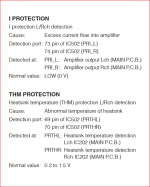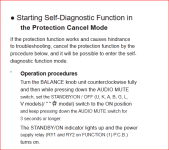Some days ago I had to repair a Korg Electribe MX. A rotory encoder had to be replaced. To fix the main board I had to dismantle 3 layers and remove at least 50 srews. This took about 30 min. So what?Fortunately this pic doesn't show the many dozens (literally!!) of small screws that hold all the pieces together ;-)!
I counted two dozens alone for the bottom panel.
Best regards!
@Kay
I reread the thread but I may have missed this step, do you or can you disconnect parts of this amp to see if its behavior changes?
I can't see in the photo how it is built and I don't know if it's possible but that's what I do on complex machines and when the error codes don't help me or send me into several different directions.
Do you see the idea?
I reread the thread but I may have missed this step, do you or can you disconnect parts of this amp to see if its behavior changes?
I can't see in the photo how it is built and I don't know if it's possible but that's what I do on complex machines and when the error codes don't help me or send me into several different directions.
Do you see the idea?
https://www.diyaudio.com/community/threads/yamaha-dsp-ax750se-dead-no-power.216317/page-2I saw that yes, this amp was built like a Mclaren LMP1.
I only see two paths emerging.
either you disassemble it (long and tedious)
either you entrust it to a yamaha station (fast and expensive)
Honestly, I don't believe for a minute that there is a capacitor problem in this amp.
the choice of components has nothing to do with the "common" range from Yamaha.
They really are two different worlds.
We cannot compare a Mercedes Class-A 160 and an SLR AMG.
From what I read in other places this Yamaha A-S series are very sensitive to external factors like switching on other gear, changing input selector, even a guy changing the speed selector on a attached Revox and so on. This shouldn't happen with such expensive amps but that's where we and many other people have to deal with. There is even this thread:
https://www.avforums.com/threads/problem-with-yamaha-a-s2000-amplifier.1876909/
I would try to measure that cap in the PSU (if possible without dismantling).
Other than that, I have had cases where the remote control was faulty, emitting wrong signals (mostly with TV sets). I'm not saying this is the case here but I'd definitely remove the batteries or put that remote in another room.
Furthermore: Intriguing problem and interesting thread.
Hugo
https://www.avforums.com/threads/problem-with-yamaha-a-s2000-amplifier.1876909/
I would try to measure that cap in the PSU (if possible without dismantling).
Other than that, I have had cases where the remote control was faulty, emitting wrong signals (mostly with TV sets). I'm not saying this is the case here but I'd definitely remove the batteries or put that remote in another room.
Furthermore: Intriguing problem and interesting thread.
Hugo
I didn't say that it didn't exist, I had to repair a good hundred of them myself, but that only concerns the entry and mid-range and considered consumable.
This is the top of the range, it has nothing to do with the rest.
Here's another one that had to move his amp downstairs and it played without issues. Played fine at the repair center too.very sensitive to external factors
Not in his living room.
https://www.stereonet.com/forums/topic/82014-why-does-my-yamaha-as1000-keep-going-into-protect-mode/
Hugo
Just passing on the info I found that led to a solution:
https://www.hifivision.com/threads/yamaha-a-s2000-experience.70171/
https://www.hifivision.com/threads/yamaha-a-s2000-experience.70171/post-779370
A few posts down the amp is working fine or fixed by either using a constant voltage transformer or replacing some 'hard to find' Sanyo transistors in the PSU.
Hugo
https://www.hifivision.com/threads/yamaha-a-s2000-experience.70171/
https://www.hifivision.com/threads/yamaha-a-s2000-experience.70171/post-779370
A few posts down the amp is working fine or fixed by either using a constant voltage transformer or replacing some 'hard to find' Sanyo transistors in the PSU.
Hugo
That raises a question of whether or not there has been some recent purchase of an appliance with an SMPS.From what I read in other places this Yamaha A-S series are very sensitive to external factors like switching on other gear, changing input selector, even a guy changing the speed selector on a attached Revox and so on. This shouldn't happen with such expensive amps but that's where we and many other people have to deal with. There is even this thread:
https://www.avforums.com/threads/problem-with-yamaha-a-s2000-amplifier.1876909/
I would try to measure that cap in the PSU (if possible without dismantling).
Other than that, I have had cases where the remote control was faulty, emitting wrong signals (mostly with TV sets). I'm not saying this is the case here but I'd definitely remove the batteries or put that remote in another room.
Furthermore: Intriguing problem and interesting thread.
Hugo
And if it wouldn't be worth it to try the amp in another house.That raises a question of whether or not there has been some recent purchase of an appliance with an SMPS.
The only appliance with a SMPS that was active when the amp stopped reproducing was the Yamaha CD-S300 CD player at it's input. I've bought both units the same time about two years ago.
Yes, I also have the amp's remote control, but usually I don't use it.
Best regards!
Yes, I also have the amp's remote control, but usually I don't use it.
Best regards!
We have had problems with ant infestations in summer. They seem like the taste of plastic in power outlet points. and invade when the power is off. Turning power on cooks them with attendant swishing noise. There is always oxidation onthe copper prongs and contacts in the box. There are ways to clean these points without electrocuting oneself.
reading the different experiences that Netlist has posted, it's not really reassuring about Yamaha after-sales service stations.
personally I don't know any and therefore I can't judge
personally I don't know any and therefore I can't judge
Yes, BSST, I was listening to music as the amp suddenly became silent. Hence, I don't think that a RFI supression capacitor that is shorted during normal operation can be the culprit, as suggested above.
Best regards!
Best regards!
There is a sub-transformer in series with the on switch which feeds a full wave rectifier to charge C2 to a level of 9 Volts. This is reduced to 5.6 Volts by IC506 which illuminates the Micro standby LED. There is another Micro feed to IC411 connecting to REM, and separately to IC504 "standby control" connecting to "Control around Tone control /Volume expanded IC"
There is a relay connecting to C2 live end through a resistor and relay with a transistor Q2 connecting to ground.
The respective circuit numbers for these three micro connections are +5M, +3M and +5S (possibly this to activate Q2 the shunt of some IC506 current to ground in order to turn the LED off)
I am attaching the Block Diagram protection information from the Service Manual. It is not clear if those other than the power supply protection have been tested. We know this is not working properly and it cannot be forced to do so by increasing PRV from an external source.
There is a number of checks to be made for components in the sub transformer area - rectifier diodes, C2 and various IC's etc as mentioned in the first paragraph.
There is a relay connecting to C2 live end through a resistor and relay with a transistor Q2 connecting to ground.
The respective circuit numbers for these three micro connections are +5M, +3M and +5S (possibly this to activate Q2 the shunt of some IC506 current to ground in order to turn the LED off)
I am attaching the Block Diagram protection information from the Service Manual. It is not clear if those other than the power supply protection have been tested. We know this is not working properly and it cannot be forced to do so by increasing PRV from an external source.
There is a number of checks to be made for components in the sub transformer area - rectifier diodes, C2 and various IC's etc as mentioned in the first paragraph.
Attachments
@ Kay
I don't know if you've given up or if you're completely on your amp but I see a lot of short and negative answers despite a lot of suggestions proposed and a lot of research work.
I understand that, like every human being, you have a life and things to do but we need you to inform us of what you are doing to avoid us going in all directions.
@mjona
still impressive
I don't know if you've given up or if you're completely on your amp but I see a lot of short and negative answers despite a lot of suggestions proposed and a lot of research work.
I understand that, like every human being, you have a life and things to do but we need you to inform us of what you are doing to avoid us going in all directions.
@mjona
still impressive
I would add: and with a probable huge satisfaction. 🙂either you disassemble it (long and tedious)
Of course a possible risk factor exists too.
I don't trust any technician I don't know, preferring the risks I personally run, if/when possible.either you entrust it to a yamaha station (fast and expensive)
However I think one has to be mad enough either way. 😉
Really we could, even if the result appears obvious (so even interesting just for that), but I believe absolute reliability does not exist.We cannot compare a Mercedes Class-A 160 and an SLR AMG.
Despite this reality I "hope" you're crazy enough to try it anyway. 👍Fortunately this pic doesn't show the many dozens (literally!!) of small screws that hold all the pieces together ;-)!
By the way I assume that you have verified the operationality even by disconnecting the speakers in order to esclude a short circuit of any kind, of course.
As a side note also please note that I liked 2 posts by @Lism audio not only for their content, but also because I thought he deserved a "thanks". ☕
it's not a question of reliability but a question of the range of components chosen + different engineering.Really we could, even if the result appears obvious (so even interesting just for that), but I believe absolute reliability does not exist.
in my life, I have worked in many areas but always in troubleshooting and yes, the level of range does not make reliability.
Today, I even see machines where there is the "deactivate protection" function, this is to say where we have reached, and the worst is that very often the machine is not broken, but the more often it is the tolerance margins of the protection or monitoring circuit which are too narrow and as they age, the monitored components and the monitoring components themselves change their value which results in a safety setting for no reason.
always my opinion and my stone in the building.
- Home
- Amplifiers
- Solid State
- Yamaha A-S3000 ceased from working

